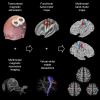Connectivity defines the distinctive anatomy and function of the hand-knob area
- PMID: 39239149
- PMCID: PMC11375856
- DOI: 10.1093/braincomms/fcae261
Connectivity defines the distinctive anatomy and function of the hand-knob area
Abstract
Control of the hand muscles during fine digit movements requires a high level of sensorimotor integration, which relies on a complex network of cortical and subcortical hubs. The components of this network have been extensively studied in human and non-human primates, but discrepancies in the findings obtained from different mapping approaches are difficult to interpret. In this study, we defined the cortical and connectional components of the hand motor network in the same cohort of 20 healthy adults and 3 neurosurgical patients. We used multimodal structural magnetic resonance imaging (including T1-weighted imaging and diffusion tractography), as well as functional magnetic resonance imaging and navigated transcranial magnetic stimulation (nTMS). The motor map obtained from nTMS compared favourably with the one obtained from functional magnetic resonance imaging, both of which overlapped well within the 'hand-knob' region of the precentral gyrus and in an adjacent region of the postcentral gyrus. nTMS stimulation of the precentral and postcentral gyri led to motor-evoked potentials in the hand muscles in all participants, with more responses recorded from precentral stimulations. We also observed that precentral stimulations tended to produce motor-evoked potentials with shorter latencies and higher amplitudes than postcentral stimulations. Tractography showed that the region of maximum overlap between terminations of precentral-postcentral U-shaped association fibres and somatosensory projection tracts colocalizes with the functional motor maps. The relationships between the functional maps, and between them and the tract terminations, were replicated in the patient cohort. Three main conclusions can be drawn from our study. First, the hand-knob region is a reliable anatomical landmark for the functional localization of fine digit movements. Second, its distinctive shape is determined by the convergence of highly myelinated long projection fibres and short U-fibres. Third, the unique role of the hand-knob area is explained by its direct action on the spinal motoneurons and the access to high-order somatosensory information for the online control of fine movements. This network is more developed in the hand region compared to other body parts of the homunculus motor strip, and it may represent an important target for enhancing motor learning during early development.
Keywords: TMS; connectivity; hand knob; motor; tumour.
© The Author(s) 2024. Published by Oxford University Press on behalf of the Guarantors of Brain.
Conflict of interest statement
The authors report no competing interests.
Figures






References
-
- Déjérine JJ, Déjérine-Klumpke A. Anatomie des Centres Nerveux. Vol. 1. Rueff et Cie; 1895.
-
- Meynert T. Psychiatry: A clinical treatise on diseases of the fore-brain based upon a study of its structure, functions, and nutrition. G.P. Putnam’s Sons; 1885.
-
- Rosett J. Intercortical systems of the human cerebrum. Columbia University Press; 1933.
-
- Schmahmann JD, Pandya DN. Fiber pathways of the brain. Oxford University Press; 2006.
-
- d’Albis MA, Guevara P, Guevara M, et al. Local structural connectivity is associated with social cognition in autism spectrum disorder. Brain. 2018;141(12):3472–3481. - PubMed
Grants and funding
LinkOut - more resources
Full Text Sources
